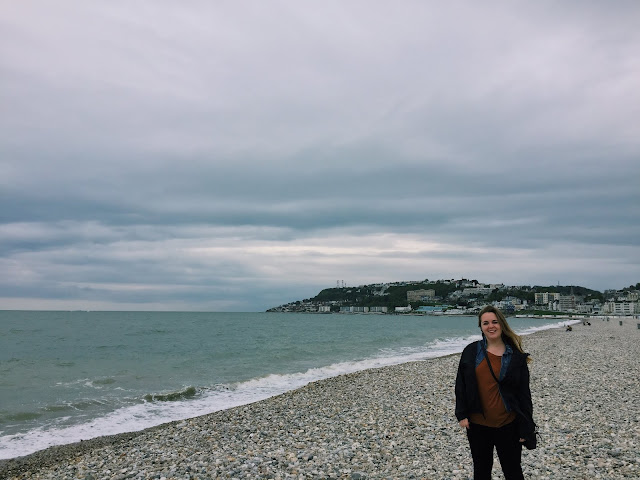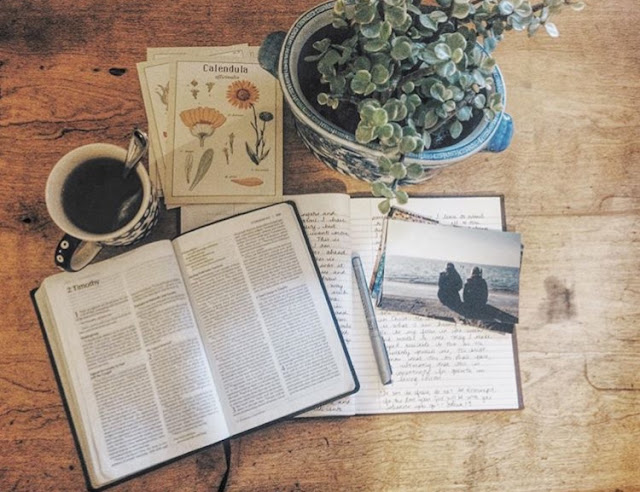normandie et bretagne
Next, we made way to Normandy and Brittany (la Normandie et la Bretagne, in French), which are two regions on the West Coast of France. My word, God went on some sort of creative rampage when He made this area of the world. It was absolutely stunning.
During our time in Western France, we stayed in three cities which allowed for easy access to the main attractions we hoped to visit: Le Havre, Rennes and Quimper.
First, Le Havre. To be honest, this was perhaps the part of the trip that spoke to me the least. Having been completely destroyed during the war, Le Havre's buildings were quite modern and (in my opinion) lacked character. There also was not much to do, as this was a beach town at a non-beachy time of year. That said, our time by the ocean really was lovely, and we had no regrets going.
From Le Havre, we went to Étretat. My goodness. This is a must when in Normandy. This little commune is famous for its beautiful rock formations and white cliffs, with the greenest grass rolling around them. The cliffs include the Porte d'Aval arch and l'Aiguille, which is a kind of pillar which rises up from the water. It looked like a dramatic, striking painting- I needn't find words to describe it further. I think the pictures speak for themselves.
Rennes, the second city we stayed in, was so much fun. It's in the east of Brittany, and filled with University students and so much culture and energy! I couldn't get over the quirky, half-timbered homes (dating from medieval times!). They were colorful and fun, and spoke to the hospitality and warmth of the town's people! Everyone was so friendly and helpful, and we loved our time visiting the Rennes Cathedral, the city's parks, the Vilaine river, outdoor bookshops, etc.
From Rennes, we visited Mont-St Michel. This was a bucket-list item of mine, and boy did it not disappoint. It's quite a long way out to the island commune, but we felt the walk would be worth it so we could get pictures of the village from afar, in the mist. It gave the place such a mystical feel, and I was overwhelmed by how majestic it was as the mist cleared out and we saw the island in full. The commune was very touristy (I should've expected this, but was a bit taken aback as we tried making our way around!), but kept its quaint and rustic allure. Note to those hoping to stay there: make sure you research tides, or you could find yourself in a similar situation as Tom Hanks in Castaway.
The abbey was striking. It was large and filled with detail and history. Without having planned it, we walked into a chapel where a mass was taking place. A dozen nuns were singing overwhelmingly beautiful hymns, and I was so moved by the pulchritude of the moment. I felt an undeniable tension there; on one hand, I was witnessing something sacred, something that was drawing me to God's greatness and glory. Yet, on the other hand, I was holding my camera and a map of the abbey, and my group walked off to continue the tour of the area. I guess that is the tension of being a tourist in a religious place: the sacred-profane dichotomy is concretized in a glimpse of a moment.
Anyway.
We also toured St-Malo when staying in Rennes. Ah. What a nice spot. Its a Romanesque/ Gothic port city in Brittany, with hues of blue and white and a beautiful, long beach. Other than a seagull pooping on us (wear hats, people) and a terrible sunburn (wear sunscreen, people), St-Malo was without a doubt one of my favorite parts of the trip. Fun fact: it is the birthplace of Jacques Cartier, was rebuilt after the war thanks to funds from Quebec, and has a "Quebec square". On se sentait chez nous! It was so relaxing to flop ourselves onto the beach and read all afternoon (it was a too cold for swimming, but just resting by the ocean was fine by us!).
Also. How could I write a piece about France without talking food? In these areas, you can't miss out on the crepes, cider, caramel (although I'm not a big caramel fan, my friends and sister went crazy and said it was the absolute best), seafood, rillettes and foie gras. Those were the delicacies of the region. Since we were four students traveling with somewhat limited budgets, we went the Airbnb route in France (which is always nice, as it gives you a great idea of how locals live!), and made our breakfasts and a couple other meals in our flats. If you're in a similar situation, a great thing to look into is "Picard" (French people swear by it!) which is a famous retailer of frozen foods, selling gourmet French food. Listen- it's not gastronomy, but it was by far the best frozen food I'd ever tried! It was a cheap and delicious alternative to a restaurant! One evening, we had the most fun prepping a little charcuterie dinner. A definite thing to do, to encourage local producers!
Finally, we stayed in Quimper. We loved Quimper for its traditional "Breton" Celtic character. It had lovely canals, old buildings, a beautiful cathedral and great local restaurants and commerces.
From Quimper, we went to Pont-Aven, which my parents had visited 25 years ago and fallen in love with. Pont-Aven is an idyllic little commune which is famous for its art scene in the late 19th century. Artists such as Paul Gauguin and Émile Bernard had lived there, and it was mainly in this area that the Synthetism movement was born (I won't even try to explain it, but read up on it here). Needless to say, we spent a few hours in the museum of fine arts of Pont-Aven, and it was lovely.
When in this part of Western Brittany, one must absolutely taste kouign amann. This Breton cake is a pride in the region. Its layers of butter and sugar quite litterally melt in your mouth- it's basically heaven. Don't miss out on it (but don't go too crazy either).
Our last day trip was in an area of Brittany called Pointe du Raz (pronounced with a silent "z"). The area consists of cliffs and a promontory by the Atlantic Ocean. I spoke a bit of how I experienced it here.
I read once that in Celtic spirituality, a "thin place" refers to a place where the boundary between heaven and earth is especially thin. It's a place where the divine/ spiritual and the earthly are interwoven in a beautiful chaos that leaves the human in awe.
I think Pointe du Raz just might be one of them.
During our time in Western France, we stayed in three cities which allowed for easy access to the main attractions we hoped to visit: Le Havre, Rennes and Quimper.
First, Le Havre. To be honest, this was perhaps the part of the trip that spoke to me the least. Having been completely destroyed during the war, Le Havre's buildings were quite modern and (in my opinion) lacked character. There also was not much to do, as this was a beach town at a non-beachy time of year. That said, our time by the ocean really was lovely, and we had no regrets going.
From Le Havre, we went to Étretat. My goodness. This is a must when in Normandy. This little commune is famous for its beautiful rock formations and white cliffs, with the greenest grass rolling around them. The cliffs include the Porte d'Aval arch and l'Aiguille, which is a kind of pillar which rises up from the water. It looked like a dramatic, striking painting- I needn't find words to describe it further. I think the pictures speak for themselves.
Rennes, the second city we stayed in, was so much fun. It's in the east of Brittany, and filled with University students and so much culture and energy! I couldn't get over the quirky, half-timbered homes (dating from medieval times!). They were colorful and fun, and spoke to the hospitality and warmth of the town's people! Everyone was so friendly and helpful, and we loved our time visiting the Rennes Cathedral, the city's parks, the Vilaine river, outdoor bookshops, etc.
From Rennes, we visited Mont-St Michel. This was a bucket-list item of mine, and boy did it not disappoint. It's quite a long way out to the island commune, but we felt the walk would be worth it so we could get pictures of the village from afar, in the mist. It gave the place such a mystical feel, and I was overwhelmed by how majestic it was as the mist cleared out and we saw the island in full. The commune was very touristy (I should've expected this, but was a bit taken aback as we tried making our way around!), but kept its quaint and rustic allure. Note to those hoping to stay there: make sure you research tides, or you could find yourself in a similar situation as Tom Hanks in Castaway.
Anyway.
We also toured St-Malo when staying in Rennes. Ah. What a nice spot. Its a Romanesque/ Gothic port city in Brittany, with hues of blue and white and a beautiful, long beach. Other than a seagull pooping on us (wear hats, people) and a terrible sunburn (wear sunscreen, people), St-Malo was without a doubt one of my favorite parts of the trip. Fun fact: it is the birthplace of Jacques Cartier, was rebuilt after the war thanks to funds from Quebec, and has a "Quebec square". On se sentait chez nous! It was so relaxing to flop ourselves onto the beach and read all afternoon (it was a too cold for swimming, but just resting by the ocean was fine by us!).
Finally, we stayed in Quimper. We loved Quimper for its traditional "Breton" Celtic character. It had lovely canals, old buildings, a beautiful cathedral and great local restaurants and commerces.
From Quimper, we went to Pont-Aven, which my parents had visited 25 years ago and fallen in love with. Pont-Aven is an idyllic little commune which is famous for its art scene in the late 19th century. Artists such as Paul Gauguin and Émile Bernard had lived there, and it was mainly in this area that the Synthetism movement was born (I won't even try to explain it, but read up on it here). Needless to say, we spent a few hours in the museum of fine arts of Pont-Aven, and it was lovely.
When in this part of Western Brittany, one must absolutely taste kouign amann. This Breton cake is a pride in the region. Its layers of butter and sugar quite litterally melt in your mouth- it's basically heaven. Don't miss out on it (but don't go too crazy either).
Our last day trip was in an area of Brittany called Pointe du Raz (pronounced with a silent "z"). The area consists of cliffs and a promontory by the Atlantic Ocean. I spoke a bit of how I experienced it here.
I read once that in Celtic spirituality, a "thin place" refers to a place where the boundary between heaven and earth is especially thin. It's a place where the divine/ spiritual and the earthly are interwoven in a beautiful chaos that leaves the human in awe.
I think Pointe du Raz just might be one of them.











































Comments